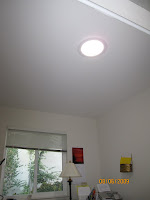 Tomorrow it will be December, but for the past month my house has remained a comfortable temperature even though I've yet to turn on the gas to the furnace this season.
Tomorrow it will be December, but for the past month my house has remained a comfortable temperature even though I've yet to turn on the gas to the furnace this season.
My house is now at 70 deg because I baked some pumpkin pie filling for an hour. The inside of my house has been reaching daytime temperatures of 68-71 deg this past week, depending on how sunny it's been (or not) and how much baking I've been doing.
It's past 9 PM and I'm sitting here with just an apron over my silk shirt, not even needing to wear a sweater. It's 59 deg F outside, not normal for December eve.
Friends have asked me how I've made my house (built in 1972) so comfortable even without the furnace operational. I meant to share all the details long ago, but here's the brief, simplified explanation of how I did it.
1) I don't have an overly large house to begin with. Our house is assessed at 1,050 square feet. It's a single story townhouse, an end unit with one shared wall.
2) While in college I was an intern at the Southface Energy Institute where I received hands-on training how to make houses energy efficient. I do have a degree in engineering, but it's not rocket science. Just a few things to be cautious about when retrofitting so that you don't create a fire hazard or put the structural integrity at risk.
3) A few months after moving in, experiencing a hot spell in May in which our house became nearly uninhabitable, I discovered that our attic only had a couple inches of insulation. So I fixed that in a hurry. That deserves a detailed blog post in itself.
4) Over the next several years, I sealed and insulated the ducts in my attic, added more attic insulation, blew insulation into my walls, and replaced our single-pane aluminum frame windows with double-paned ones.
I did much of the work myself and with the help of a friend and at times some inexpensive hired help, except for the window installation. I'm told that window replacement is easy, but that's one project I was happy to pay professionals to do.
5) Weather-stripping makes a huge difference. This also deserves a more detailed post.
6) Much later, I also installed radiant barrier in the attic, but that mostly helps with keeping the house cool in the summer rather than warm in the winter, I think.
7) I had a large piece of plexiglass that I'd inherited from my folks, which my neighbor helped me trim to fit in my front doorway. I drilled some holes to put handles on either side. It's too short for the doorway so I stuff some foam padding in on top when I have it placed there. Because I have a south-facing front door, the plexi lets me turn my entryway into a low-tech passive solar collector when the sun is low in the sky, as it is in the fall, winter and spring. Even a half hour of partial sun can increase the house temperature by two degrees F.
All in all, I spent maybe $1,200 on materials, $1,000 on labor, plus $5,500 on the window replacement. Plus about 2-3 months of my life spread out over a decade. But now I have a super comfortable house with utility bills that average $25/month. I don't let the house get colder than 63 or 64 deg overnight. The day that I can't get my house to at least 66 deg during the day is the day I turn on the furnace for the season. We have a solar hot water preheater installed, but no solar PV yet. The furnace is the original 80% efficient one installed in 1972.
I also ripped out the wall-to-wall carpeting and had cork flooring installed. That helped the house be better insulated from the cold concrete subfloor also. But the biggest difference came with the attic insulation.
During that process I also put in backer rod at the bottom of the wall behind the baseboard and sealed with acoustic caulk. My house now fends off insect invasions as well. Unlike most people around here, I leave food out in the kitchen all the time and do not have any ant invasions. I have many fewer spiders, cobwebs, or creepy crawlies than I used to. And I don't use any poisonous traps around my house at all.
Very recently, I had the asbestos tile and icky vinyl removed from my kitchen floor. Then I put down a paper floor over a layer of cork-rubber underlayment. That deserves a separate blog post as well. Anyway now I have a very comfortable, artsy, insulated and functional kitchen floor. I love it. And it probably helps keep the heat in a smidgen.



